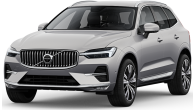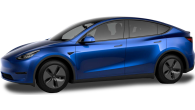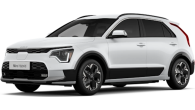Here's a fun fact for you to chew over; when Alexander Graham Bell invented the telephone, back in 1876, he couldn't find a buyer for his patent, no matter how hard he tried. And try he did, attempting to flog his invention everywhere he could, right up until the biggest communications company of the time wrote off the "obvious limitations" of his device, which they derided as "hardly more than a toy".
Now, keep that in mind as you read this (more than likely on one of the very toys his invention eventually begat). Obvious limitations. Hardly more than a toy. Don't they sound an awful lot like the very accusations levelled at electric cars?
Now to be fair, I'm guilty of slinging the very same insults. The Tesla Model X irks me like a fire-ant swimsuit (though not as much as it apparently irks company boss, and Twitter enthusiast, Elon Musk). But having just driven Jaguar's new and all-electric I-Pace, I can't shake the feeling I'm about to be left languishing on the wrong side of history.
.jpg)
Because this is an electric SUV that's at home in the city, can acquit itself off road, and can even paint an ear-to-ear smile on your face on the right twisting road.
So, is Jaguar's exciting first EV both zero emissions and zero compromises?
Jaguar I-Pace 2018: Ev400 Hse Awd (294Kw)
| Engine Type | Not Applicable, 0.0L |
|---|---|
| Fuel Type | Electric |
| Fuel Efficiency | 0.0L/100km (combined) |
| Seating | 5 |
| Price From | $60,720 - $69,740 |
| Safety Rating |
|
Does it represent good value for the price? What features does it come with?
Expect a three-strong regular line-up (S, SE and HSE), as well as a feature-packed First Edition, when the I-Pace lands in Australian dealerships in October.
The $119,900 S gets 18-inch alloy wheels, LED headlights and auto-parking, while the cabin scores powered seats, navigation, a 380-watt premium Meridian sound system and the 'Flight Deck' multimedia set-up (a 10-inch screen sitting above a 5.0-inch screen) which we will touch on shortly. While Apple CarPlay and Android Auto are not yet available, the ink is apparently drying on the contract and the service should be offered in Australian cars by the time they land here.
.jpg)
The $130,200 SE trim gets bigger 20-inch wheels and an auto-opening boot outside, while the cabin materials are upgraded to real leather. Finally, the $140,800 HSE trim gets diamond-turned alloys, Matrix LED headlights, a better sound system and top-shelf 'Windsor' leather seats. Spring for the First Edition ($159,700) car and you'll add a head-up display, a fixed sunroof, four-zone climate control, and customisable interior lighting, as well as a boosted 825-watt stereo with 15 speakers.
There's some clever new tech on show here, too, like a Bluetooth-enabled key that tells the car who is approaching, so your seat, steering wheel and stereo settings can be pre-prepared. An app will tell you how much battery you have left, or how long you'll have to wait to finish charging, while an AI-enabled assistant can even learn your habits and remind you of things you might have forgotten. If you always call home at 3.15pm to check on the kids, for example, and one day you forget, the I-Pace will remind you.
.jpg)
You'll have noticed, I'm sure, that those prices look pretty good against the other electric SUV in the field, with Tesla's Model X prices spanning from $133k to a a whopping $244k. And having spent time in the Silicon Valley version, I can tell you the Jaguar definitely does not feel like a cheaper offering...
.jpg)
Is there anything interesting about its design?
Electric cars are free of the cumbersome, non-negotiable elements of an internal-combustion drivetrain, and so they can pretty much look however a designer wants them to. Sure enough, the Jaguar I-Pace - which began life as a blank piece of paper in a designer's sketchpad - was originally going to showcase all the weird and wonderful things an EV design could be.
But then Jaguar had a change of heart, and the design team instead opted for a much more conventional look. Sure, parts of the bodywork have been dictated by aerodynamics, but mostly it's a car that looks like a car should, and one that isn't all that radically removed from the rest of the Jaguar stable.
For mine, that was absolutely the right decision. Talking people into electric cars is a hard enough sell without designing something that looks like it fell off the set of The Jetsons. The car world wasn't exactly swooning when pics of this I-Pace were first released, but for mine, it looks much better in the metal. And viewed from the front or rear, it looks pretty great. It does stretch the definition of the term "SUV", though, looking more like a sedan-hatch mix.

"EVs are not a quirky idea anymore," Jaguar's chief exterior designer, Matthew Beaven, told CarsGuide. "It's going to be the future, so the design shouldn't have to try so hard."
Viewed front-on, the I-Pace looks very conventional indeed. The engine bay is still there (though now it's home to soft-bag storage), and there's even the traditional silver-ringed mesh grille - albeit tucked in at the top to feed cold air onto the car's battery-cooling systems.
Inside, the cabin debuts Jag's new "flight deck" dash design; a two-tier digital system that integrates a sizeable touchscreen with the digital aircon controls. It's an insanely complicated system (really, it takes A LOT of getting used to) but it looks mighty fine.
The materials in our test cars were all sumptuous and lovely, too, with a fine mix of soft leathers lining the dash and doors, and that sense of premium extends to the rear seats, where backseat riders are also ensconced in luxurious-feeling surrounds.
.jpg)
How practical is the space inside?
With no pesky engine to contend with, Jaguar was able to extend the cabin further forward, resulting in what they claim to be the interior space of a vehicle one size bigger.
It's 4682mm long, 2139mm wide and 1565mm tall, and it sits on a 2990mm wheelbase. That makes it smaller and shorter than the brand's F-Pace SUV - though it is wider - but the cabin feels every bit as spacious in either row of seats.
In the backseat especially you'll find oodles of space, with plenty of head and legroom, and enough shoulder space to fit three across the back with some degree of comfort.
.jpg)
Up front, expect the usual array of technology connections (there are three 12-volts outlets and six USB connections in the cabin), as well as two cupholders and the bottle storage in each of the front doors. Climb into the back, and you'll find air vents, bottle storage and a pair of cupholders hidden in the pull-down seat divider, as well as ISOFIX attachment points in the outward seats.
The storage is seriously clever, too, with laptop stowage under the rear seats, another 10 litres of storage in the centre console, and a sizeable 656 litres of space (and 1453 litres with the rear seats folded down) in the boot.
.jpg)
What are the key stats for the engine and transmission?
No old-world fuel burning here, with a pair of electric motors (one at each axle), paired with a single-speed transmission, providing all your propulsion needs.
Together, they provide 294kW and 696Nm (which is plenty), and they help push the I-Pace to 100km/h in a very brisk-feeling 4.8 seconds. Top speed, however, is a less impressive 200km/h.
Perhaps because they know people will pine for the old, there's even a 'creep mode' (a name that might need a rethink), which will see the I-Pace mimic a traditional setup, inching forward when you first take your foot off the accelerator.
.jpg)
How much fuel does it consume?
.jpg)
Zero, zip, nada. Instead, you'll get a claimed 480km from the 90kWh lithium-ion batteries on board. Be warned; you're about as likely to actually get that number as you are to achieve the manufacturer's claimed fuel economy on a regular car...
Charging takes a 12.9 hours on regular power (though you can get 80 per cent in 10 hours), but should you have access to a fast-charger - and there will be more and more of them in years to come - you can get an 80 per cent charge in just 10 minutes.
What's it like to drive?
Jaguar makes a point of referring to its I-Pace as a "performance SUV" - at least partly to tackle the ludicrous antics of the Tesla Model X - and it is seriously quick and seriously accomplished when you drive it in anger.
One of the very coolest things about electrification is the new and utterly bizarre style of performance it unlocks, and the I-Pace makes full use of it. Plant your foot and there's no pausing to gather its wits. Instead the I-Pace lunges forward, attacking the road ahead with a ferocity that, while you're still getting used to it, genuinely makes you laugh out loud.
.jpg)
The overall numbers on offer aren't outrageous - especially for the EV world - but it's the way that power is delivered that makes you smile. Breathe on the accelerator, and every ounce of torque arrives in this crowding rush, so much so that you end up covering the distance between corners in a way that feels far faster than a conventional car. It's weird, of course, but it's most definitely a good kind of weird.
Engaging 'Dynamic' firms up the suspension and adds weight to the (not hugely talkative steering), and with everything firmed up, the I-Pace feels super flat and composed in tight corners, and you really need to push it to elicit a warning squeal from the tyres. The standard torque-vectoring system does a massively commendable job of warding off understeer, athough it can't work miracles.
It does feel heavy, of course, and even the all-new and all-aluminium body structure can't totally compensate for the 600kg of extra battery weight, but they are housed down and low and spread out in a way that allows Jaguar to claim a perfect 50/50 weight distribution. Still, you can feel the extra weight, with slow-speed stuff especially feeling like its bulk is following you into corners.
.jpg)
But it's away from the red mist of a racetrack or a twisting road where the Jaguar is perhaps most impressive. For one, you cant help but notice the staggering normality of the drive experience. We covered plenty of low-speed and freeway suff, tootling through and between villages and towns, and provided you're a little gentle with the super-reactive throttle, it's a calm and comfortable experience.
Jaguar even unleashed us upon a water crossing (a substance that famously mixes well with electricity) and up a scrabbling off-road hill climb, and the I-Pace conquered all with absolute ease.
The ride is really impressive, and the cabin, unsurprisingly, is quiet. So much so that you can actually dial up how much car noise you want in the cabin, just in case the silence creeps you out. Bad road surfaces do send plenty of tyre noise into the cabin, though.
Our test cars had some quirks, though. The air-conditioning gave out on the right side of the cabin, for example, not long before a colleague was unable to deactivate his seat heater. Another vehicle developed a worrying vibration under hard acceleration, too.
Warranty & Safety Rating
What safety equipment is fitted? What safety rating?
Standard safety kit includes AEB, lane-keep assist, a reversing camera with 360-degree view and rear cross-traffic assist. The SE and HSE trims add adaptive cruise, blind-spot assist and high-speed emergency braking. The I-Pace is yet to be tested by ANCAP.
What does it cost to own? What warranty is offered?
Jaguar's standard three-year, unlimited-kilometre warranty applies to the I-Pace, and the service intervals are an impressive 24 months or 34,000kms. Or to put it in the words of one Jaguar executive, "we don't want to see our customers for two years".
Jaguar is also in the process of rolling out 150 fast-charging points across its dealership network, all of which will be available for customers to use.
Verdict
Park your EV preconceptions at the door with this one. The Jaguar I-Pace is a comfortable, capable and - dare we say it - exciting SUV that offers the perks of fuel-free motoring without any obvious compromises.
It does take an awfully long time to charge on mains power, though, meaning the technology is still better suited to inner-city dwellers than it is to long-distance commuters.








.jpg)
.jpg)






















.png)














